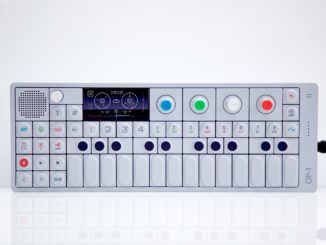It’s official: Waldorf discontinues the Kyra FPGA-based virtual analog Synthesizer… but what happens to the code?
It all started at Musikmesse 2018 as Exodus Digital Valkyrie. The developer presented the synth there for the first time and it was a stunning-sounding VA Synthesizer. A short time later, Waldorf took over the project from Manuel Caballero. This became the Kyra synth, presented with an all-new Axel Hartmann design at NAMM 2019.
Today, we get the bad news: only four years after its release, the Waldorf and Kyra chapter will soon end again. They officially discontinues the Kyra and sell off the last units.
Waldorf Discontinues Kyra
On the sheet, the Kryra is an exciting virtual analog synthesizer (VA) with many features. FPGA-based engine, 128 voices, 8-part multi-timbral, two oscillators per voice with 4096 waveforms, hard-sync, hypersaw, FM/ring mod, two filters per voice, effects, and more.
Kyra was also able to convince with the sound in all areas. For many, it was the spiritual successor to the Access Virus. However, the Kyra has its own sound, making it a modern VA Synthesizer—so Virus-like but not a replica/clone.
Since the release, however, the euphoria for Kyra has steadily decreased. This is mainly due to the care of the device. It’s no secret anything software-based is not 100% bug-free. For this reason, there are regular firmware updates for synths, drum machines, samplers… So everywhere, where code can cause problems that sometimes make one or more features not work.
Waldorf has not done this work very often in recent years. The last major update for Kyra was in 2020, and nothing relevant since then. In the official forum and social media, Kyra users have been upset that the device has bugs that have not yet been fixed, including user-requested improvements that have not been considered for a future update.
I asked Waldorf several times about this, and they said it’s a tricky situation. They didn’t want to give me a specific statement on this, but I think it’s up to the person who wrote Kyra’s code, Manuel Cabellero. He is not a Waldorf employee but works at Samsung in the HARMAN division. So, they would have to get Manual back on board to fix the unit and bring it to a new level. Unfortunately, that was not done.
Further, features already shown in the Valkyrie in 2018 were not taken over to the Kyra. Above all, a complete editor that was strongly reminiscent of the concept of the total integration of Access. There was hope for this, but it was never implemented.
What Happens To The Code?
Manuel Cabellero has developed a great-sounding virtual analog engine here. If not one of the best-sounding ones in recent years. Many are asking this question: what happens to Manuel’s code? Will Waldorf use it differently, or will it just be left to die?
I’d love to see Waldorf make the code open-source if the latter is the case. This would allow community-driven developers to create firmware updates that existing customers have long waited for. And even give the Kyra maybe a second life with an improved engine, etc.
One thing is for sure: the Kyra Synthesizer was/is a great modern VA Synthesizer. However, Waldorf’s mismanagement (lack of updates, no open communication…) has given the tool a bad reputation in the community, resulting in bad sales and constant price drops at dealers. It’s also a pity that the much-praised FPGA base and the engine were never used to their full potential.
There’s only one thing left for me to say: RIP Kyra
The last Waldorf Kyra units are now available on the official website and at retailers. On the official website, you get it for 1.774,80€ (10% OFF) and a backpack for free. On Thomann, it’s available for 1599€ but without the custom backpack.
More information here: Waldorf
Available at my partner






Absolutely disgusting how Waldorf & Cabellero have acted.
Users paid thousands for the Kyra only to be abandoned.
An absolute f*cking disgrace.
Never buy from Waldorf.
Hey, they are selling it with a 10% discount rotfl!!!
And did you saw the blue SAME_AS_F@CK edition?
;))))))))))))))))))))
It feels like the Kyra didn’t sell as well as Waldorf hoped. If the developer didn’t get paid much, he may have chosen not to update the firmware simply because spending hundreds of hours coding might not have earned him anything.
The arrangement between Cabellero and Waldorf was never going to work. They essentially took a synth that needed a considerable amount of work/optimisation, refinement, and a commitment to develop and support, and believed they could repackage it via Axel (and that is another issue of a person whom thinks far too highly of himself) and believed this would be enough to push an unfinished product to production and the hands of clients/musicians/and hobbyists.
And this was a poor fit with the methodical approach Waldorf has taken with their entire product range. They did not have the considerable resources needed to support and allow this product to mature.
It’s a shame as this had great potential.
Who knows what really went on between Waldorf and Mr Cabellero. Picking up small bits of information its seems Waldorf purchased the rights to market the synth, brought in Alex Hartmann to redesign the physical parts but the rights for the firmware stayed with Mr Cabellero who lost interest in the Kyra once in Waldorfs hands. It’s a great synth even with its short comings.
True story. Never waldorf again, for me.
Modern3, is that you still violating the IP rights and trademark of the nice hairdresser in Kalamazoo?:)
https://www.modern3.com/default.asp
We have no doubt that you think yourself better and smarter than Axel – which instruments have you designed?
And you, frodo, are you still better and smarter than a fairy-tale dragon because you use software and not hardware?:D
Back under the hill with you…
Haha. Well played Sir.
How cute that you and toy boy Dongle have this moment.
I have worked for independently, contractually, and as a consultant for various pro audio companies. My day job is in aerospace industry.
And Axel is a tool. I’ve had the misfortune of having to deal with him. It was never a good experience. You needn’t rely on my experience, just peruse the web since you’re good it and you may actually pick up something.
I see you don’t have anything of value to add to this thread. Again.
What are you talking about?????
I was interested in this synth and followed it for the years it took to get to market. I then lost all interest in the final unit based on two things: They made it both look like and cost like a piece of hospital equipment. It also seemed to have a weak effects section.
I don’t think large companies like this ever release the code. The code in projects like this might include code that was purchased from an external party; making it public would be a violation.
FGPAs are notoriously difficult to program and a very different approach from ‘normal’ coding. This probably contributed to the Kyra’s demise. Reminds me a bit of the situation with the DSI Tempest, that wasn’t FGPA but it was another hardware platform that was complex and difficult to develop for (limited memory, multiple processors for different tasks so several different firmwares etc).
Bringing the Kyra to the open source community has the potential to make it profitable for Waldorf to keep it in their catalogue. I understand the feeling of owners to be left with an expensive machine without perspective on support.
On the other hand, most hardware of Waldorf is supported fro a very long time, like the Blofeld.
that could cause problems is the technology behind it, it uses FPGA tech but I’m pretty sure there many talent developers out there
This is my petition to make the code open source. Please sign it!
https://chng.it/TzxXvV7Mzh
Well done, signed. I don’t have this synth however I do believe synth companies owe their customers more than a boot in the rear when they determine to abandon a platform. And I highly doubt that will have much interest in the SC for a future product. Allow the community to support and develop this synth moving forward.
Monkey business from Waldorf.
I do have the synth and do use it. It was bought for a specific project in 2020 and it did what it was supposed to do. I do like it, sounds great, and is well built and the specs are insane. The OS has bugs and shortcomings and It does have some things here and there, just about like with every other synth out there… The two reasons why I bought it:
— Insane spaces
— Waldorf logo on it
However, Waldorf should not drop the ball like they did. They never supported as they should have done with an instrument costing thousands of $. Would I ever buy Waldorf again? I do not think so, even if the next synth they make is something made in the planet Mars 🙂 There are plenty of developers making amazing stuff that they’re proud of and fully support. It never felt like Waldorf wanted to back Kyra. Regardless of whatever issues they may have had with the initial developer of the synth, they should have found a way to not let the buyers of a Waldorf instrument out in the wilderness 4 years after release.
Just my 2 cents…
In the end, Waldorf killed the self-appointed “virus killer” while the Hydrasynth Deluxe peaks at 16 notes of polyphony, and the circus is going on. 20 years ago the Virus TI was a monster and a revolution, 20 Years later the Virus TI is still the king. Why nobody was able to outperform the Virus in 20 years is for me a mystery. Maybe only an Access Virus 3 might do that 😀
20 years ago Access Virus Ti doesn’t even existed 😉 I buyed used Virus B few years ago. I like it very much, but when I heard Kyra… I think of it every single day. I only think of it, because the price is out of my range 😛
Virus, 1997, 26 years ago. Same year as the Roland JP 8000.
Virus TI, 2005, 18 years ago. Pretty close to 20 years 😉
Virus TI 2, 2009, 14 years ago. Still unmatched.
Kyra was a nice idea, sadly it never had a chance considering the way it was managed.
My 14 year old Yamaha Motif XS does 128 note polyphony and for the same price it came with a weighted 88-keybed.
Korg did with the multiengine (NTS-1, prologue, minilogue xd) what i hoped Waldorf would do with the Kyra: Open the system for developers, so the community could add functionality to the synth. Korg made their “logue SDK” a success, Waldorf failed to do so. Sad for this nice and powerful FPGA hardware platform.
no real loss